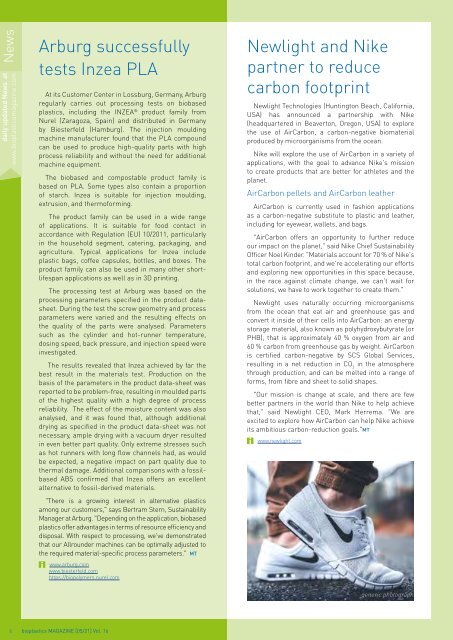issue 05/2021
Highlights: Fibres, Textiles, Nonwovens Biocomposites Basics: CO2-based plastics
Highlights:
Fibres, Textiles, Nonwovens
Biocomposites
Basics: CO2-based plastics
You also want an ePaper? Increase the reach of your titles
YUMPU automatically turns print PDFs into web optimized ePapers that Google loves.
News<br />
daily updated News at<br />
www.bioplasticsmagazine.com<br />
Arburg successfully<br />
tests Inzea PLA<br />
At its Customer Center in Lossburg, Germany, Arburg<br />
regularly carries out processing tests on biobased<br />
plastics, including the INZEA ® product family from<br />
Nurel (Zaragoza, Spain) and distributed in Germany<br />
by Biesterfeld (Hamburg). The injection moulding<br />
machine manufacturer found that the PLA compound<br />
can be used to produce high-quality parts with high<br />
process reliability and without the need for additional<br />
machine equipment.<br />
The biobased and compostable product family is<br />
based on PLA. Some types also contain a proportion<br />
of starch. Inzea is suitable for injection moulding,<br />
extrusion, and thermoforming.<br />
The product family can be used in a wide range<br />
of applications. It is suitable for food contact in<br />
accordance with Regulation (EU) 10/2011, particularly<br />
in the household segment, catering, packaging, and<br />
agriculture. Typical applications for Inzea include<br />
plastic bags, coffee capsules, bottles, and boxes. The<br />
product family can also be used in many other shortlifespan<br />
applications as well as in 3D printing.<br />
The processing test at Arburg was based on the<br />
processing parameters specified in the product datasheet.<br />
During the test the screw geometry and process<br />
parameters were varied and the resulting effects on<br />
the quality of the parts were analysed. Parameters<br />
such as the cylinder and hot-runner temperature,<br />
dosing speed, back pressure, and injection speed were<br />
investigated.<br />
The results revealed that Inzea achieved by far the<br />
best result in the materials test. Production on the<br />
basis of the parameters in the product data-sheet was<br />
reported to be problem-free, resulting in moulded parts<br />
of the highest quality with a high degree of process<br />
reliability. The effect of the moisture content was also<br />
analysed, and it was found that, although additional<br />
drying as specified in the product data-sheet was not<br />
necessary, ample drying with a vacuum dryer resulted<br />
in even better part quality. Only extreme stresses such<br />
as hot runners with long flow channels had, as would<br />
be expected, a negative impact on part quality due to<br />
thermal damage. Additional comparisons with a fossilbased<br />
ABS confirmed that Inzea offers an excellent<br />
alternative to fossil-derived materials.<br />
"There is a growing interest in alternative plastics<br />
among our customers," says Bertram Stern, Sustainability<br />
Manager at Arburg. "Depending on the application, biobased<br />
plastics offer advantages in terms of resource efficiency and<br />
disposal. With respect to processing, we've demonstrated<br />
that our Allrounder machines can be optimally adjusted to<br />
the required material-specific process parameters." MT<br />
www.arburg.com<br />
www.biesterfeld.com<br />
https://biopolymers.nurel.com<br />
Newlight and Nike<br />
partner to reduce<br />
carbon footprint<br />
Newlight Technologies (Huntington Beach, California,<br />
USA) has announced a partnership with Nike<br />
(headquartered in Beaverton, Oregon, USA) to explore<br />
the use of AirCarbon, a carbon-negative biomaterial<br />
produced by microorganisms from the ocean.<br />
Nike will explore the use of AirCarbon in a variety of<br />
applications, with the goal to advance Nike's mission<br />
to create products that are better for athletes and the<br />
planet.<br />
AirCarbon pellets and AirCarbon leather<br />
AirCarbon is currently used in fashion applications<br />
as a carbon-negative substitute to plastic and leather,<br />
including for eyewear, wallets, and bags.<br />
"AirCarbon offers an opportunity to further reduce<br />
our impact on the planet," said Nike Chief Sustainability<br />
Officer Noel Kinder. "Materials account for 70 % of Nike's<br />
total carbon footprint, and we're accelerating our efforts<br />
and exploring new opportunities in this space because,<br />
in the race against climate change, we can't wait for<br />
solutions, we have to work together to create them."<br />
Newlight uses naturally occurring microorganisms<br />
from the ocean that eat air and greenhouse gas and<br />
convert it inside of their cells into AirCarbon: an energy<br />
storage material, also known as polyhydroxybutyrate (or<br />
PHB), that is approximately 40 % oxygen from air and<br />
60 % carbon from greenhouse gas by weight. AirCarbon<br />
is certified carbon-negative by SCS Global Services,<br />
resulting in a net reduction in CO 2<br />
in the atmosphere<br />
through production, and can be melted into a range of<br />
forms, from fibre and sheet to solid shapes.<br />
"Our mission is change at scale, and there are few<br />
better partners in the world than Nike to help achieve<br />
that," said Newlight CEO, Mark Herrema. "We are<br />
excited to explore how AirCarbon can help Nike achieve<br />
its ambitious carbon-reduction goals."MT<br />
www.newlight.com<br />
generic photograph<br />
6 bioplastics MAGAZINE [<strong>05</strong>/21] Vol. 16

















